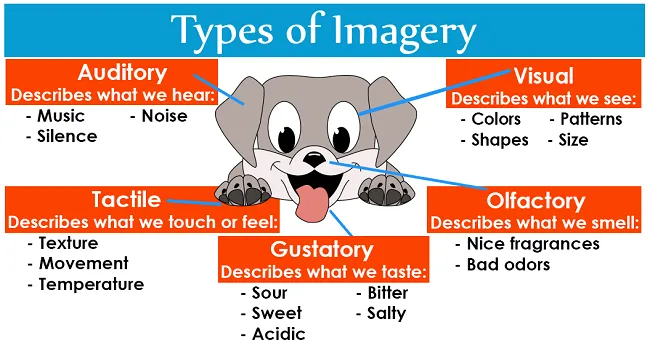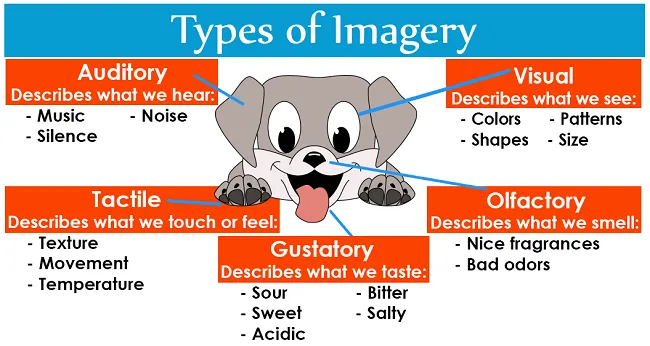I. What is Imagery?
Imagery is language used by poets, novelists and other writers to create images in the mind of the reader. Imagery includes figurative and metaphorical language to improve the reader’s experience through their senses.
Bạn đang đọc: Imagery: Definition and Examples | sentayho.com.vn
II. Examples of Imagery
Example 1
Imagery using visuals:
The night was black as ever, but bright stars lit up the sky in beautiful and varied constellations which were sprinkled across the astronomical landscape.
In this example, the experience of the night sky is described in depth with color (black as ever, bright), shape (varied constellations), and pattern (sprinkled).
Example 2
Imagery using sounds:
Silence was broken by the peal of piano keys as Shannon began practicing her concerto.
Here, auditory imagery breaks silence with the beautiful sound of piano keys.
Example 3
Imagery using scent:
She smelled the scent of sweet hibiscus wafting through the air, its tropical smell a reminder that she was on vacation in a beautiful place.
The scent of hibiscus helps describe a scene which is relaxing, warm, and welcoming.
Example 4
Imagery using taste:
The candy melted in her mouth and swirls of bittersweet chocolate and slightly sweet but salty caramel blended together on her tongue.
Thanks to an in-depth description of the candy’s various flavors, the reader can almost experience the deliciousness directly.
Example 5
Imagery using touch:
After the long run, he collapsed in the grass with tired and burning muscles. The grass tickled his skin and sweat cooled on his brow.
In this example, imagery is used to describe the feeling of strained muscles, grass’s tickle, and sweat cooling on skin.
III. Types of Imagery
Here are the five most common types of imagery used in creative writing:
Tìm hiểu thêm: App Vault là gì? Cách sử dụng và quản lý App Vault cho Xiaomi – Làm cha cần cả đôi tay

>>>>>Xem thêm: Vải Polyester là gì? Đặc tính của chất liệu vải này! – Đệ Nhất Nệm
a. Visual Imagery
Visual imagery describes what we see: comic book images, paintings, or images directly experienced through the narrator’s eyes. Visual imagery may include:
- Color, such as: burnt red, bright orange, dull yellow, verdant green, and Robin’s egg blue.
- Shapes, such as: square, circular, tubular, rectangular, and conical.
- Size, such as: miniscule, tiny, small, medium-sized, large, and gigantic.
- Pattern, such as: polka-dotted, striped, zig-zagged, jagged, and straight.
b. Auditory Imagery
Auditory imagery describes what we hear, from music to noise to pure silence. Auditory imagery may include:
- Enjoyable sounds, such as: beautiful music, birdsong, and the voices of a chorus.
- Noises, such as: the bang of a gun, the sound of a broom moving across the floor, and the sound of broken glass shattering on the hard floor.
- The lack of noise, describing a peaceful calm or eerie silence.
c. Olfactory Imagery
Olfactory imagery describes what we smell. Olfactory imagery may include:
- Fragrances, such as perfumes, enticing food and drink, and blooming flowers.
- Odors, such as rotting trash, body odors, or a stinky wet dog.
d. Gustatory Imagery
Gustatory imagery describes what we taste. Gustatory imagery can include:
- Sweetness, such as candies, cookies, and desserts.
- Sourness, bitterness, and tartness, such as lemons and limes.
- Saltiness, such as pretzels, French fries, and pepperonis.
- Spiciness, such as salsas and curries.
- Savoriness, such as a steak dinner or thick soup.
e. Tactile Imagery
Lastly, tactile imagery describes what we feel or touch. Tactile imagery includes:
- Temperature, such as bitter cold, humidity, mildness, and stifling heat.
- Texture, such as rough, ragged, seamless, and smooth.
- Touch, such as hand-holding, one’s in the grass, or the feeling of starched fabric on one’s skin.
- Movement, such as burning muscles from exertion, swimming in cold water, or kicking a soccer ball.
IV. The Importance of Using Imagery
Because we experience life through our senses, a strong composition should appeal to them through the use of imagery. Descriptive imagery launches the reader into the experience of a warm spring day, scorching hot summer, crisp fall, or harsh winter. It allows readers to directly sympathize with characters and narrators as they imagine having the same sense experiences. Imagery commonly helps build compelling poetry, convincing narratives, vivid plays, well-designed film sets, and descriptive songs.
V. Imagery in Literature
Imagery is found throughout literature in poems, plays, stories, novels, and other creative compositions. Here are a few examples of imagery in literature:
Example 1
Excerpt describing a fish:
his brown skin hung in strips
like ancient wallpaper,
and its pattern of darker brown
was like wallpaper:
shapes like full-blown roses
stained and lost through age.
This excerpt from Elizabeth Bishop’s poem “The Fish” is brimming with visual imagery. It beautifies and complicates the image of a fish that has just been caught. You can imagine the fish with tattered, dark brown skin “like ancient wallpaper” covered in barnacles, lime deposits, and sea lice. In just a few lines, Bishop mentions many colors including brown, rose, white, and green.
Example 2
Another example:
A taste for the miniature was one aspect of an orderly spirit. Another was a passion for secrets: in a prized varnished cabinet, a secret drawer was opened by pushing against the grain of a cleverly turned dovetail joint, and here she kept a diary locked by a clasp, and a notebook written in a code of her own invention. … An old tin petty cash box was hidden under a removable floorboard beneath her bed.
In this excerpt from Ian McEwan’s novel Atonement, we can almost feel the cabinet and its varnished texture or the joint that is specifically in a dovetail shape. We can also imagine the clasp detailing on the diary and the tin cash box that’s hidden under a floorboard. Various items are described in-depth, so much so that the reader can easily visualize them.
VI. Imagery in Pop Culture
Imagery can be found throughout pop culture in descriptive songs, colorful plays, and in exciting movie and television scenes.
Example 1
Wes Anderson’s Fantastic Mr. Fox:
Wes Anderson is known for his colorful, imaginative, and vivid movie making. The imagery in this film is filled with detail, action, and excitement.
Example 2
Louis Armstrong’s “What a Wonderful World.”
Armstrong’s classic song is an example of simple yet beautiful imagery in song. For instance, the colors are emphasized in the green trees, red blooming roses, blue skies, and white clouds from the bright day to the dark night.
VII. Related Terms
(Terms: metaphor, onomatopoeia and personification)
Metaphor
Metaphor is often used as a type of imagery. Specifically, metaphor is the direct comparison of two distinct things. Here are a few examples of metaphor as imagery:
- Her smiling face is the sun.
- His temper was a hurricane whipping through the school, scaring and amazing his classmates.
- We were penguins standing in our black and white coats in the bitter cold.
Onomatopoeia
Onomatopoeia is also a common tool used for imagery. Onomatopoeia is a form of auditory imagery in which the word used sounds like the thing it describes. Here are a few examples of onomatopoeia as imagery:
- The fire crackled and popped.
- She rudely slurped and gulped down her soup.
- The pigs happily oinked when the farmer gave them their slop to eat.
Personification
Personification is another tool used for imagery. Personification provides animals and objects with human-like characteristics. Here are a few examples of personification as imagery:
- The wind whistled and hissed through the stormy night.
- The tired tree’s branches moaned in the gusts of wind.
- The ocean waves slapped the shore and whispered in a fizz as they withdrew again.

